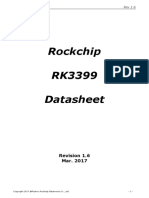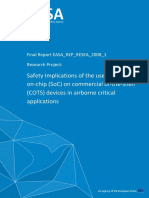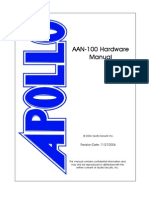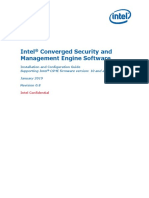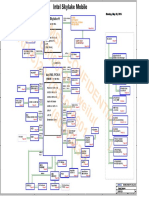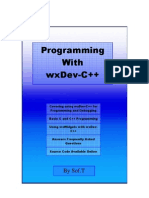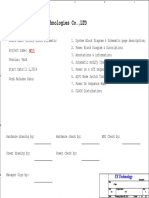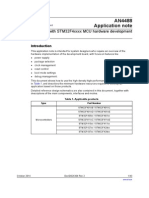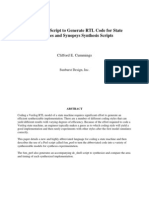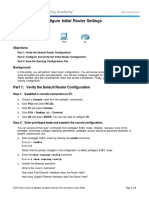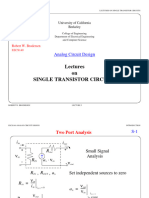NAND Vs NOR Flash Memory Technology Overview Read Write Erase Speed For SLC MLC Semiconductor Consulting Expert
NAND Vs NOR Flash Memory Technology Overview Read Write Erase Speed For SLC MLC Semiconductor Consulting Expert
Uploaded by
varunmrCopyright:
Available Formats
NAND Vs NOR Flash Memory Technology Overview Read Write Erase Speed For SLC MLC Semiconductor Consulting Expert
NAND Vs NOR Flash Memory Technology Overview Read Write Erase Speed For SLC MLC Semiconductor Consulting Expert
Uploaded by
varunmrOriginal Title
Copyright
Available Formats
Share this document
Did you find this document useful?
Is this content inappropriate?
Copyright:
Available Formats
NAND Vs NOR Flash Memory Technology Overview Read Write Erase Speed For SLC MLC Semiconductor Consulting Expert
NAND Vs NOR Flash Memory Technology Overview Read Write Erase Speed For SLC MLC Semiconductor Consulting Expert
Uploaded by
varunmrCopyright:
Available Formats
NAND vs.
NOR Flash Memory
Technology Overview
Introduction Flash memory has become a powerful and cost-effective solid-state storage technology widely used in mobile electronics devices and other consumer applications. Two major forms of Flash memory, NAND Flash and NOR Flash, have emerged as the dominant varieties of non-volatile semiconductor memories utilized in portable electronics devices. NAND Flash, which was designed with a very small cell size to enable a low cost-per-bit of stored data, has been used primarily as a high-density data storage medium for consumer devices such as digital still cameras and USB solid-state disk drives. NOR Flash has typically been used for code storage and direct execution in portable electronics devices, such as cellular phones and PDAs. Recently, however, the distinction between the two types of Flash memory has become less clear. New cell phone controllers that support NAND Flash as an alternative to or an addition to NOR Flash have helped make NAND a viable alternative for a broader array of applications. In addition, data storage capacity and performance requirements in cell phones have increased significantly with the growth of feature-rich phones that incorporate camera, music, video, gaming and other functionality. NAND Flash has become an attractive alternative for the data storage aspects of todays cell phones because of its higher speed write and erase performance as well as its low cost-per-bit. As a result, designers of memory subsystems in portable electronics are now using NAND in some traditional NOR-based applications. For todays full-featured cell phones, many designers are utilizing memory architectures that combine NOR with NAND for data storage, or are using NAND as the primary Flash memory in combination with low power DRAM in which the program code can be shadowed and run. In either case, the different types of memory are frequently stacked in Multi-Chip Packages (MCP) to create a single component. This overview will briefly discuss the history of Flash memory development, compare and contrast NAND and NOR Flash memory, and discuss the ways in which the two technologies are used today. Figure 1 below provides a summary of how NAND and NOR Flash vary for a number of important design characteristics: capacity, read speed, write speed, active and standby power consumption, cost-per-bit, and ease of use for file storage and code storage applications. more
Toshiba NAND vs. NOR Flash Memory Technology Overview
Page 2
Fig. 1 Comparison of NOR and NAND Flash
Cost-per-bit
NOR NAND
Standby Power
Low Low Easy
File Storage Use
High Hard
Low
High Low
Easy
Active Power (*)
(*) : Dependant on how memory is used. NOR is typically slow on writes and consumes more power than NAND. NOR is typically fast on reads, which consume less power. High Low
Code Execution
High
Read Speed
High
Capacity
Write Speed
The History of Flash Memory As a recognized pioneer in flash technology, Toshiba was a principal innovator of both NORtype and NAND-type Flash technology in the 1980s. These new memories were developed to address the need for a non-volatile memory that is easily reprogrammable within a system. Some kind of non-volatile memory is necessary for computing systems so that the system does not erase all data every time it is powered down, or following a power failure. Both NOR and NAND Flash systems are electrically erasable solutions, and can write and erase data many times, but do not lose stored data when the power is turned off.
NAND and NOR Flash Memory Architecture In the internal circuit configuration of NOR Flash, the individual memory cells are connected in parallel, which enables the device to achieve random access. This configuration enables the short read times required for the random access of microprocessor instructions. NOR Flash is ideal for lower-density, high-speed read applications, which are mostly read only, often referred to as code-storage applications. NAND Flash was developed as an alternative optimized for high-density data storage, giving up random access capability in a tradeoff to achieve a smaller cell size, which translates to a smaller chip size and lower cost-per-bit. This was achieved by creating an array of eight memory transistors connected in a series. Utilizing the NAND Flash architectures high storage density and smaller cell size, NAND Flash systems enable faster write and erase by programming blocks of data. NAND Flash is ideal for low-cost, high-density, high-speed program/erase applications, often referred to as data-storage applications.
Toshiba NAND vs. NOR Flash Memory Technology Overview
Page 3
NOR vs. NAND Flash Density For any given lithography process, the density of the NAND Flash memory array will always be higher than NOR Flash. In theory, the highest density NAND will be at least twice the density of NOR, for the same process technology and chip size. In reality, market forces determine the highest density that will be commercially produced. Today, comparing only single chip memory with one bit per cell (also called Single Level Cell, or SLC), the highest density NOR commercially available is 256 megabit1 (Mb), while NAND is available in densities of 4 gigabit2 (Gb). Because cost-per-bit, which is closely related to the silicon real estate required, is one of the most important characteristics of memory, the small cell size characteristic of NAND Flash is a significant factor. Choosing NAND vs. NOR Toshiba continues to make both types of Flash memory, and recognizes that both forms have their own unique merits. When should one choose NAND Flash over NOR Flash? The answer depends on the system requirements. Figure 4 below compares NAND Flash with asynchronous NOR Flash in terms of various operating and performance characteristics: SLC NAND Flash (x8)
Density Read Speed Write Speed Erase Time Interface Application 512 Mbits1 4 Gbits2 24 MB/s3 8.0 MB/s 2.0 mSec I/O indirect access Program/Data mass storage
MLC NAND Flash (x8)
1Gbit to 16Gbit 18.6 MB/s 2.4 MB/s 2.0mSec I/O indirect access Program/Data mass storage
MLC NOR Flash (x16)
16Mbit to 1Gbit 103MB/s 0.47 MB/s 900mSec Random access eXecuteInPlace
Figure 4: NAND and NOR Flash Operating Specifications The characteristics of NAND Flash are: high density, medium read speed, high write speed, high erase speed, and an indirect or I/O like access. The characteristics of NOR Flash are lower density, high read speed, slow write speed, slow erase speed, and a random access interface. For a system that needs to boot out of Flash, execute code from the Flash, or if read latency is an issue, NOR Flash may be the answer. However, for storage applications, NAND Flashs higher density, and high programming and erase speeds make it the best choice. While the benefit of high programming speed in high-density Flash devices is obvious, erase performance is equally important, though less obvious. Unlike magnetic memory systems (hard disk drives and tape drives), Flash memory requires a separate erasing step in order to turn all bits back to the 1 state before the device is programmed. Power is another important concern for many applications. For any write-intensive applications, NAND Flash will consume significantly less power. Although the instantaneous power (voltage current) figures between NOR Flash and NAND Flash appear comparable, total energy will be significantly higher for NOR Flash since energy = power * time.
Toshiba NAND vs. NOR Flash Memory Technology Overview
Page 4
When a system, such as a camera phone, has a requirement both for code execution and high capacity data storage, designers may need to consider alternatives and tradeoffs, such as using both types of Flash memory, possibly in combination with Pseudo Static RAM (PSRAM), or using NAND as the Flash memory in combination with low power DRAM in which to run the operating code. The best Flash memory to choose will be the one that offers the required performance and density at the lowest cost. About Multi-Chip Packages (MCP) Toshiba MCPs (Multi Chip Packages) provides an advanced packaging solution for applications requiring smaller size, higher capacity and faster speed. MCPs can combine NAND Flash, NOR Flash memory, Pseudo SRAM and/or low power DRAM in a single package by using chipstacking technology. This advanced packaging technology enables a complete memory subsystem with different types of semiconductor memory to be packaged as a single component to reduce size and contribute to cost reduction for cellular phones and other portable devices. # # #
When used herein, megabit and/or Mb means 1,024x1,024 = 1,048,576 bits. Usable capacity may be less. For details, please refer to specifications. 2 When used herein, gigabit and/or Gb means 1,024x1,024x1,024 = 1,073,741,824 bits. Usable capacity may be less. For details, please refer to specifications. 3 For purposes of measuring data transfer rate in this context, megabyte (MB) per second, MB/s and/or MBps = 1,000,000 bytes per second. Information in this document, including product pricing and specifications, content of services and contact information, is current and believed to be accurate on the date it was created, but is subject to change without prior notice. Technical and application information contained here is subject to the most recent applicable Toshiba product specifications. In developing designs, please ensure that Toshiba products are used within specified operating ranges as set forth in the most recent Toshiba product specifications and the information set forth in Toshibas Handling Guide for Semiconductor Devices, or Toshiba Semiconductor Reliability Handbook. This information is available at www.chips.toshiba.com, or from your TAEC representative. Internet Address http://www.chips.toshiba.com Public Relations Contact MultiPath Communications International: Jan Johnson (714) 633-4008, jan@multipathcom.com or Carol Bardia, (949) 481-5867, carol@multipathcom.com Reader Inquiry Contact Tech.Question@taec.toshiba.com Updated 4-25-06
1
You might also like
- 2023 02 Ansys General Hardware RecommendationsDocument24 pages2023 02 Ansys General Hardware RecommendationsDayvid Melo BrittoNo ratings yet
- Inteliconfig: Global GuideDocument178 pagesInteliconfig: Global GuideMarbin Claure JaillitaNo ratings yet
- Certificacion AADocument19 pagesCertificacion AASoporte Fami100% (1)
- Pic-Programming-With-Ccs-C - (Cuuduongthancong - Com) PDFDocument135 pagesPic-Programming-With-Ccs-C - (Cuuduongthancong - Com) PDFbenjarrayNo ratings yet
- IRIS Programmers ManualDocument144 pagesIRIS Programmers ManualcallibanNo ratings yet
- DDR SDR Sdram ComparisionDocument12 pagesDDR SDR Sdram ComparisionSrinivas CherukuNo ratings yet
- Intel® Core™ Voltage Regulator-Down (VRD) 11.1 - Processor Power Delivery Design GuidelinesDocument132 pagesIntel® Core™ Voltage Regulator-Down (VRD) 11.1 - Processor Power Delivery Design Guidelinesaqua01No ratings yet
- Open Compute Project Intel Motherboard v2.0 YGMDocument32 pagesOpen Compute Project Intel Motherboard v2.0 YGMgawinNo ratings yet
- Dev Kit 8000Document5 pagesDev Kit 8000Shiva prasadNo ratings yet
- Rockchip RK3399 Datasheet V1.6Document72 pagesRockchip RK3399 Datasheet V1.6alcNo ratings yet
- Hardware DesignDocument42 pagesHardware DesignSruthi PaletiNo ratings yet
- MT6737 LTE Smartphone Application Processor Functional Specification V1.0Document288 pagesMT6737 LTE Smartphone Application Processor Functional Specification V1.0copslockNo ratings yet
- Booting Process: DateDocument18 pagesBooting Process: DateSwaroop P SNo ratings yet
- Memory Notes1Document102 pagesMemory Notes1nirmal_inbox100% (1)
- U Blox6 ReceiverDescriptionProtocolSpec GPS.G6 SW 10018Document222 pagesU Blox6 ReceiverDescriptionProtocolSpec GPS.G6 SW 10018Bruno SuarezNo ratings yet
- Breed - Manual-EnDocument48 pagesBreed - Manual-EnZriastyNo ratings yet
- Design Implementation of Nios II Processorfor Low Powered Embedded SystemsDocument8 pagesDesign Implementation of Nios II Processorfor Low Powered Embedded SystemsSingam SridharNo ratings yet
- SP Racing F3 FC Board (Deluxe) Internal OSD ManualDocument5 pagesSP Racing F3 FC Board (Deluxe) Internal OSD ManualibyselfNo ratings yet
- TN4602 PDFDocument3 pagesTN4602 PDFMarcel BlinduNo ratings yet
- Easa Rep Resea 2008 1Document99 pagesEasa Rep Resea 2008 1MESUT TOZANNo ratings yet
- MediaTek LinkIt Smart 7688 Duo Pin Out v1 3Document1 pageMediaTek LinkIt Smart 7688 Duo Pin Out v1 3teguhscribdNo ratings yet
- Ducati2 Trouble Shooting Guide20140611 PDFDocument12 pagesDucati2 Trouble Shooting Guide20140611 PDFRiza VirsadaNo ratings yet
- TI Low Power RF: Designers Guide To LPRFDocument64 pagesTI Low Power RF: Designers Guide To LPRFShafqat UllahNo ratings yet
- Analog Magazine 55 4 1712753182Document72 pagesAnalog Magazine 55 4 1712753182Adam RayNo ratings yet
- Toshiba Nand Flash Naming Rev1.3Document15 pagesToshiba Nand Flash Naming Rev1.3prasoftNo ratings yet
- Memory Trends in iSSCC ConferenceDocument6 pagesMemory Trends in iSSCC Conferencekiranns1978No ratings yet
- Design of Ultrasonic Alarm SystemDocument28 pagesDesign of Ultrasonic Alarm Systemmesale22222100% (2)
- HP ENVY M6 Compal - La-8711p - r0.1 - Schematics PDFDocument58 pagesHP ENVY M6 Compal - La-8711p - r0.1 - Schematics PDFrahul sarkarNo ratings yet
- Arduino - SPIDocument4 pagesArduino - SPIMuhammad Fikri100% (1)
- AAN-100 Hardware Manual: Revision Date: 11/27/2006Document81 pagesAAN-100 Hardware Manual: Revision Date: 11/27/2006ali_1976sweet7448No ratings yet
- Mordax DATA - User Guide - 171002Document29 pagesMordax DATA - User Guide - 171002rustyNo ratings yet
- Mentor PADS VX2.3 Student ManualDocument45 pagesMentor PADS VX2.3 Student ManualferasNo ratings yet
- Cisco Unified CME and Cisco IOS Software Version Compatibility Matrix - CiscoDocument2 pagesCisco Unified CME and Cisco IOS Software Version Compatibility Matrix - Ciscoarada1729No ratings yet
- 11 Ways To Protect Your Power Path: Design Tips and Tradeoffs Using TI's Power SwitchesDocument62 pages11 Ways To Protect Your Power Path: Design Tips and Tradeoffs Using TI's Power SwitchesGhasemNo ratings yet
- Memory Validation List ExternalDocument285 pagesMemory Validation List ExternalEmerson ValdiviesoNo ratings yet
- Intel (R) ME SW Installation GuideDocument36 pagesIntel (R) ME SW Installation GuideJesús Gildardo Mejía CortésNo ratings yet
- Implementing A Bootloader For The PIC16F87X: OperationDocument24 pagesImplementing A Bootloader For The PIC16F87X: Operationboslim1580100% (1)
- Confidential weilu (盧偉 客戶服務部 孫飛: MSI 60000121 RD (C) 2017031015601Document62 pagesConfidential weilu (盧偉 客戶服務部 孫飛: MSI 60000121 RD (C) 2017031015601XyuNo ratings yet
- Fujitsu L7300 Laptop SchematicDocument59 pagesFujitsu L7300 Laptop SchematicvnenovNo ratings yet
- Olimexino STM32Document19 pagesOlimexino STM32numero909No ratings yet
- Course On MicrocontrollersDocument115 pagesCourse On MicrocontrollersKorom ChandNo ratings yet
- LaunchPad Ecosystem Selection Guide Slat152bDocument17 pagesLaunchPad Ecosystem Selection Guide Slat152bventsym100% (1)
- Flasher 5: Programming Tool For Serial in Circuit Programming of Microcontrollers With On-Chip FlashDocument16 pagesFlasher 5: Programming Tool For Serial in Circuit Programming of Microcontrollers With On-Chip FlashAjay AroraNo ratings yet
- PSIM User ManualDocument259 pagesPSIM User ManualCourtney JenningsNo ratings yet
- Open OcdDocument137 pagesOpen OcdBusayo OjumuNo ratings yet
- Nokia 1100 Service Manual Level 1 2Document21 pagesNokia 1100 Service Manual Level 1 2Pentti HevosahoNo ratings yet
- Programming With WxDec-C++Document155 pagesProgramming With WxDec-C++Pushpendra DwivediNo ratings yet
- LVGL v7Document173 pagesLVGL v7oanzarNo ratings yet
- EVB Schematic For RK3399ProDocument36 pagesEVB Schematic For RK3399ProChu Tiến Thịnh100% (1)
- dsPIC Microcontroller PDFDocument19 pagesdsPIC Microcontroller PDFSỹ RonNo ratings yet
- PEGATRON IPISB-SB Rev1.00 PDFDocument76 pagesPEGATRON IPISB-SB Rev1.00 PDFClaudeci100% (1)
- MICROCONTROLLER BASED SCROLLING MESSAGE DISPLAY FinalDocument20 pagesMICROCONTROLLER BASED SCROLLING MESSAGE DISPLAY FinalAyush Awasthy100% (1)
- MediaTek LinkIt Smart 7688 Pin Out v1 3Document1 pageMediaTek LinkIt Smart 7688 Pin Out v1 3Eligio VásquezNo ratings yet
- YX Technologies Co.,LTD: YX Technology YX Technology YX TechnologyDocument29 pagesYX Technologies Co.,LTD: YX Technology YX Technology YX TechnologyGustavo DestruelNo ratings yet
- DFPlayer Mini ManualDocument12 pagesDFPlayer Mini ManualShinon DasNo ratings yet
- Msis-Rma 羅覓林 2091109: Krishna (MS-7647)Document38 pagesMsis-Rma 羅覓林 2091109: Krishna (MS-7647)Multiservicio DELEDENNo ratings yet
- Stm32f4 Hardware DevelopmentDocument43 pagesStm32f4 Hardware DevelopmentrevaNo ratings yet
- Electrical Overstress (EOS): Devices, Circuits and SystemsFrom EverandElectrical Overstress (EOS): Devices, Circuits and SystemsNo ratings yet
- Embedded Linux Development using Yocto Projects - Second Edition: Learn to leverage the power of Yocto Project to build efficient Linux-based productsFrom EverandEmbedded Linux Development using Yocto Projects - Second Edition: Learn to leverage the power of Yocto Project to build efficient Linux-based productsNo ratings yet
- What Is The Difference Between NAND and NOR FlashDocument2 pagesWhat Is The Difference Between NAND and NOR Flashs parasdNo ratings yet
- Calculation of Receiver Sensitivity: T V V K T ° Where T V Calibrates Voltage As TemperatureDocument23 pagesCalculation of Receiver Sensitivity: T V V K T ° Where T V Calibrates Voltage As TemperaturevarunmrNo ratings yet
- Summary of Signal Types: PulsesDocument22 pagesSummary of Signal Types: PulsesvarunmrNo ratings yet
- Signals, Antenna and MeasurementsDocument19 pagesSignals, Antenna and MeasurementsvarunmrNo ratings yet
- Rocket IO Transceiver User GuideDocument146 pagesRocket IO Transceiver User GuidevarunmrNo ratings yet
- First Steps With Embedded SystemsDocument228 pagesFirst Steps With Embedded SystemsAlex Granizo100% (1)
- Lecture 03Document19 pagesLecture 03varunmrNo ratings yet
- Register Management With Csrcompiler An Introduction: 145 Eldora Drive Mountain View, Ca 94041 (650) 960-0925Document16 pagesRegister Management With Csrcompiler An Introduction: 145 Eldora Drive Mountain View, Ca 94041 (650) 960-0925varunmrNo ratings yet
- Nand Design GuideDocument29 pagesNand Design GuidegdvqzarNo ratings yet
- Implementing AHB PeripheralDocument29 pagesImplementing AHB PeripheralvarunmrNo ratings yet
- CummingsSNUG1999SJ FSM PerlDocument20 pagesCummingsSNUG1999SJ FSM PerlvarunmrNo ratings yet
- I2c Rev03Document17 pagesI2c Rev03varunmr100% (1)
- 6.4.1.3 Packet Tracer - Configure Initial Router Settings PDFDocument4 pages6.4.1.3 Packet Tracer - Configure Initial Router Settings PDFSyammirul RashidNo ratings yet
- Experiment 01: AIM: To Perform Data Preparation Using Numpy and Panda. TheoryDocument5 pagesExperiment 01: AIM: To Perform Data Preparation Using Numpy and Panda. TheoryNeha ChogaleNo ratings yet
- BCA 1st YEAR SyllabusDocument26 pagesBCA 1st YEAR Syllabusbhavyakumaryadav64No ratings yet
- Auto Pricelist at Pampanga YardDocument1 pageAuto Pricelist at Pampanga YardpocaxieNo ratings yet
- Motion Control Chapter 1 - IntroductionDocument43 pagesMotion Control Chapter 1 - IntroductionTrịnh Gia BảoNo ratings yet
- Transport SlidesDocument17 pagesTransport SlidesAsante EmmanuelNo ratings yet
- Chart 9Y1400 Panel Generator Serial IdentificationDocument10 pagesChart 9Y1400 Panel Generator Serial IdentificationadisalleNo ratings yet
- Cómo Escribir Un Ensayo para NjhsDocument4 pagesCómo Escribir Un Ensayo para Njhsvxrtevhjf100% (2)
- Results of Competition: Electric Vehicle Charging For Public Spaces: Feasibility Studies Competition Code: 1807 - FS - OLEV - ELEC - ST1Document45 pagesResults of Competition: Electric Vehicle Charging For Public Spaces: Feasibility Studies Competition Code: 1807 - FS - OLEV - ELEC - ST1Jack PadiNo ratings yet
- Discussion:: Reduced Partial Factors in UK Standards For Assessment of Bridges and StructuresDocument2 pagesDiscussion:: Reduced Partial Factors in UK Standards For Assessment of Bridges and StructuresChuoi O MaiNo ratings yet
- Bipolar Junction Transistor (BJT) - Part 2Document31 pagesBipolar Junction Transistor (BJT) - Part 2Khánh ĐỗNo ratings yet
- 2 Tek Transistor DevrelerDocument45 pages2 Tek Transistor DevrelerM. AymazNo ratings yet
- Load Software Test Plan (LSTP)Document11 pagesLoad Software Test Plan (LSTP)api-3834287No ratings yet
- CSE052 Risk ManagementDocument4 pagesCSE052 Risk ManagementUmar Badamasi IbrahimNo ratings yet
- NOI Netcool Annou - LetterDocument30 pagesNOI Netcool Annou - LetterFer-Nando AlvarezNo ratings yet
- Nach Blank FormDocument1 pageNach Blank FormpatilshashiNo ratings yet
- An Overview of Doffer in Carding MachineDocument2 pagesAn Overview of Doffer in Carding MachineRonak JoshiNo ratings yet
- SBMS User ManualDocument43 pagesSBMS User ManualChad AttermannNo ratings yet
- BTI Mine Runner PDFDocument8 pagesBTI Mine Runner PDFJesús Omar SolísNo ratings yet
- SOA Supports MAHB: by Mior AzharDocument4 pagesSOA Supports MAHB: by Mior AzharTiffany BaileyNo ratings yet
- What Is New in 4th Edition of API RP 580Document8 pagesWhat Is New in 4th Edition of API RP 580MOHAMMAD RAMZANNo ratings yet
- Controller For Controlling One Evaporator: EKC 414A1Document20 pagesController For Controlling One Evaporator: EKC 414A1Miteak PruteanuNo ratings yet
- MRO - Maintenance, Repair & OverhaulDocument20 pagesMRO - Maintenance, Repair & OverhaulAman OjhaNo ratings yet
- Product Specifications Product Specifications: HWXX HWXX - 6516DS 6516DS - VTM VTMDocument2 pagesProduct Specifications Product Specifications: HWXX HWXX - 6516DS 6516DS - VTM VTMЕвгений ГрязевNo ratings yet
- Network Transmission Devices - PostQuiz - Attempt ReviewDocument4 pagesNetwork Transmission Devices - PostQuiz - Attempt Reviewvinay Murakambattu100% (2)
- GAMP5 IntroductionDocument53 pagesGAMP5 IntroductionBhaskar NapteNo ratings yet
- Maruti Suzuki: Two Wheeler VehicleDocument10 pagesMaruti Suzuki: Two Wheeler VehiclePubg GamerNo ratings yet









